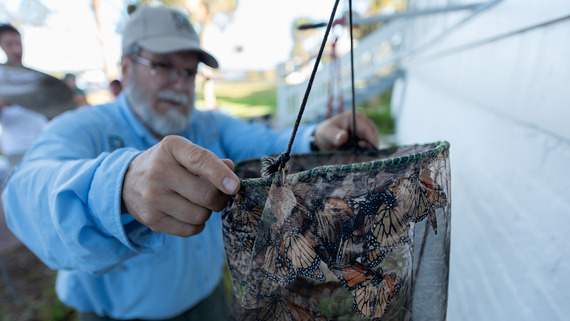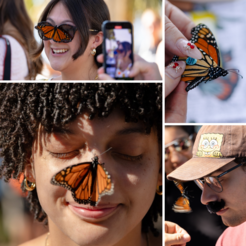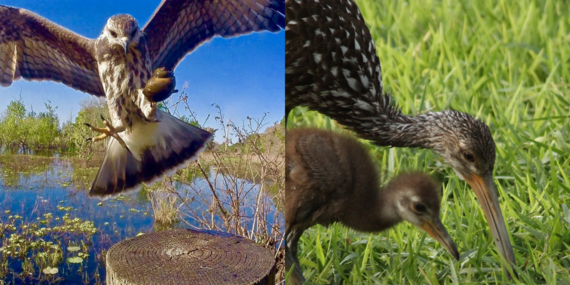 David Cook, Invertebrate Conservation Coordinator at FWC, checking on monarch butterflies to be tagged and released at the festival. Photo by FWC.
Each fall St. Marks National Wildlife Refuge hosts its Monarch Butterfly Festival, a popular event that merges scientific data collection with public outreach and education. At this year’s festival, FWC biologists, staff and partners tagged and released 269 monarch butterflies as part of a mark-recapture project spanning some 30 years. The recapture or recovery of tagged monarchs in México or elsewhere gives scientists clues about their migration route and how these migrants fit into the world monarch population.
The day before the festival, scientists and volunteers visited the Refuge before dawn and caught sleeping monarchs. In the early morning hours, migrating monarchs are clustered together on trees, resting for the long journey ahead. Despite their delicate appearance these butterflies are tough, with bodies that can survive thousands of miles of migration. The tiny scales that cover their wings do not brush off as easily as they do for other butterfly species, making monarchs quite resistant to handling. After capture the butterflies were kept in a fridge overnight, staying sleepy in the low temperatures until the festival the next morning. Scientists collected data, tagged the butterflies, and released them at the festival. For their release monarchs are placed on a festivalgoer’s nose or hand where the monarch may rest for a few seconds before flying away. Festivalgoers are delighted, and the monarch is unharmed.

St. Marks National Wildlife Refuge is a Gateway Site on FWC’s Great Florida Birding and Wildlife Trail, and the festival attracts hundreds of people every year. Check it out next year to learn more about wildlife in Florida and the biological and cultural importance of monarch butterflies across North America.
|
 Boardwalk at Sweetwater Wetlands Park. Photo provided by Sweetwater Wetlands Park.
Sweetwater Wetlands Park is one of fourteen new sites selected to join the Great Florida Birding and Wildlife Trail this year. The park recently co-hosted the Sweetwater Wetlands Park Birding Trail Celebration to commemorate its inclusion in the Trail. Trail staff visited the park and spoke with Park Recreation Leader, Darby Guyn, about what makes Sweetwater Wetlands Park special.
“Sweetwater Wetlands Park has become an internationally known birding hotspot in North Florida. People visit from all over the world, and many local birders are weekly repeat visitors. To date 262 species of birds have been recorded at the park on eBird, making it the second highest ranking spot for bird diversity in Gainesville [the first is the adjacent Paynes Prairie Preserve State Park].
Snail Kites in particular are a big draw at the park, and they can often be found flying in lazy circles over the southern distribution channel at all times of year. Limpkins are also common and serve as our unofficial mascot. Many other animals can be seen regularly, including bobcats, otters, muskrats, monarch butterflies, green water snakes and alligators. If you’re looking for something specific it’s always worth a call to the ranger station beforehand to plan your visit. If you’re interested in plants, Sweetwater has more than enough to go around! Alligator flag, American Lotus and Burr Marigolds are just a handful of the park’s plant life,” Guyn said.
The park also provides vital ecological services. Guyn explained that the area “was designed and built to clean the water coming out of Gainesville before it heads into Paynes Prairie and ultimately, the Floridan Aquifer. Water coming out of the park is the cleanest it’s been in over 100 years, and the project restored the 1300 acres of Paynes Prairie that had been dried out by canals since the early 1900s.”
 Snail Kite (right) and Limpkins (left) at Sweetwater Wetlands Park. Photos provided by Sweetwater Wetlands Park.
The park’s biodiversity is just one key to its popularity. With accessible paths, boardwalks and an electric tram, it provides a friendly middle ground between the city and Paynes Prairie, attracting everyone from seasoned birders to families, fitness fanatics and those with mobility impairments. “The park provides a safe and easy way for visitors to get into nature,” says Guyn, “and hosts a variety of educational programming including ranger tours, tram tours, tabling events, school programs, summer camp programs and night events.” April and November are peak birding months when migration is in full swing, but there’s something special to see in every season.
When asked about the park’s addition to the Great Florida Birding and Wildlife Trail, Guyn said “We’d been anxiously waiting to apply to join the Trail since the park’s opening in 2015. A couple dozen excited local birders sent us the application once it was available. We are so excited to be officially recognized by the Trail!”
Call Sweetwater Wetlands Park at 352-554-5871 or visit their Facebook page to learn more.
|